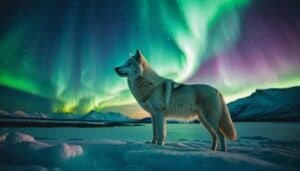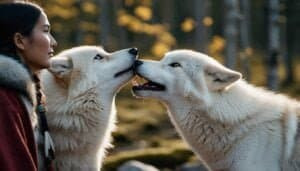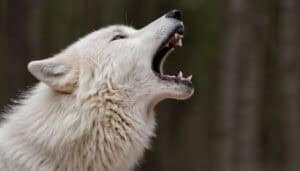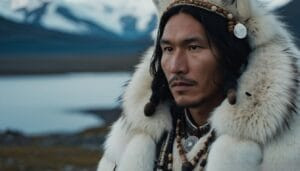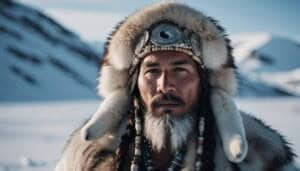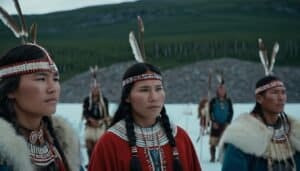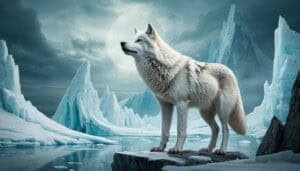Introduction
Arctic wolves hold a special place in Arctic cultures, symbolizing unity and cooperation. This article explores the multifaceted significance of Arctic wolves, delving into their role in mythology, their behavioral and ecological importance, and their depictions in art and folklore
We’ll also examine the valuable lessons these majestic creatures impart to human communities, highlighting the deep connections between Arctic wolves and the people who share their environment
The Role of Arctic Wolves in Arctic Mythology
Arctic wolves have long been central figures in the mythologies of Arctic cultures, representing strength, unity, and resilience
Their presence in various legends and stories reflects the deep connection between these animals and the people who inhabit the Arctic regions
Legends and Stories Featuring Arctic Wolves
In many Arctic cultures, wolves are seen as powerful spiritual beings. For instance, the Inuit believe that wolves were created by a deity named Torngarsuk, who is often depicted as a great hunter. These wolves are thought to be protectors and guides, leading people through the harsh and often unforgiving Arctic landscape
One prevalent legend tells of a wolf pack that saved an entire village from starvation. According to the tale, during a particularly harsh winter, a village was on the brink of despair due to a lack of food
A pack of wolves, understanding the humans’ plight, led them to a herd of caribou. The wolves’ willingness to share their prey with humans is seen as a profound act of unity and compassion, symbolizing the mutual respect and cooperation needed for survival in the Arctic
Another story from the Chukchi people speaks of a great white wolf that led a lost hunter back to his village. The wolf, believed to be a spirit animal, not only guided the hunter but also taught him valuable lessons about perseverance and the importance of family and community
This story underscores the belief that wolves are wise beings that impart essential life lessons to those willing to listen and learn
Arctic Wolves as Totemic Animals
Totemism is a widespread belief system among Arctic cultures, where certain animals are revered as spiritual symbols or ancestors of a tribe
Arctic wolves are often chosen as totems due to their notable characteristics such as loyalty, strength, and unity. These traits are not only admired but also seen as essential qualities for the survival and cohesion of the community
The Gwich’in people, for example, regard the wolf as a totemic animal that embodies the spirit of the hunter. The wolf’s hunting prowess, strategic thinking, and ability to work in a pack are qualities that the Gwich’in strive to emulate. They believe that by honoring the wolf as a totem, they can draw on its strengths and ensure their own success in hunting and other communal activities.
In other Arctic cultures, the wolf totem is associated with protection and guardianship. The presence of wolf totems in homes and villages is believed to ward off evil spirits and bring good fortune
These totems are often crafted with great care, using materials such as bone, stone, or wood, and are placed in prominent locations to serve as reminders of the wolf’s protective nature
Through these legends and totemic beliefs, Arctic wolves are deeply woven into the cultural fabric of Arctic communities. They serve as powerful symbols of unity, guiding principles, and spiritual guardians, reflecting the intertwined lives of humans and wolves in the Arctic environment
Behavioral and Ecological Significance of Arctic Wolves
Arctic wolves are not only symbolically important to Arctic cultures but also play crucial roles in their ecosystems and display behaviors that exemplify unity and cooperation. Understanding their pack dynamics and ecological contributions provides deeper insights into why these animals are so revered
Pack Dynamics and Social Structure
Arctic wolves live in tightly-knit packs that typically consist of an alpha pair, their offspring, and sometimes a few additional adults. This social structure is essential for their survival in the harsh Arctic environment
The alpha pair leads the pack, making decisions related to hunting, territory, and protection. Their leadership ensures that the pack operates efficiently and cohesively
Each member of the pack has a specific role, contributing to the overall success of the group. Younger wolves learn vital skills from the more experienced members, highlighting the importance of mentorship and cooperation. This structured social system is a prime example of unity, as each wolf relies on the others to fulfill their roles for the benefit of the pack
Wolves communicate through a variety of vocalizations, body language, and scent marking
These communication methods help maintain pack cohesion and coordinate activities such as hunting and defending territory. Howling, for instance, can serve to reunite pack members, signal the presence of intruders, or communicate with neighboring packs
Hunting and Cooperation Techniques
Hunting in the Arctic is challenging due to the scarcity of prey and the harsh conditions. Arctic wolves have adapted by developing highly cooperative hunting strategies. They often hunt in packs, which allows them to take down larger prey such as caribou and muskoxen that a single wolf could not manage alone
During a hunt, wolves use a combination of endurance, strategy, and teamwork. They may spread out to cover more ground and then work together to isolate and chase down a chosen target
The pack’s coordinated efforts and ability to communicate effectively during a hunt are critical to their success. This cooperative hunting behavior underscores the wolves’ unity and highlights how teamwork can overcome even the most formidable challenges
Role in Maintaining Ecosystem Balance
Arctic wolves play a vital role in maintaining the balance of their ecosystem. As apex predators, they regulate the populations of herbivores such as caribou, muskoxen, and Arctic hares
By keeping these populations in check, wolves help prevent overgrazing and ensure that vegetation can regenerate, which is crucial for the health of the ecosystem
Their presence also affects the behavior of their prey, often referred to as the “ecology of fear.” Prey animals change their feeding patterns and habitats to avoid areas heavily frequented by wolves, which can lead to a more even distribution of grazing pressure across the landscape
This dynamic helps maintain biodiversity and ecosystem resilience
Interactions with Other Species
Arctic wolves interact with various other species in their environment, contributing to a complex web of ecological relationships
For instance, scavengers such as Arctic foxes and ravens benefit from the wolves’ hunting activities, as they often feed on the remains of kills. This interspecies interaction exemplifies a form of ecological cooperation, where the presence of wolves supports a broader community of animals
Moreover, wolves’ predation on herbivores indirectly supports plant species by reducing grazing pressure. This cascade effect, known as a trophic cascade, demonstrates the interconnectedness of the Arctic ecosystem and the crucial role that wolves play in maintaining its health and stability
The behavioral and ecological significance of Arctic wolves provides a clear understanding of why these animals are seen as symbols of unity in Arctic cultures
Their pack dynamics, cooperative hunting strategies, and vital role in ecosystem balance highlight the importance of working together and the strength that comes from unity
Cultural Depictions and Lessons from Arctic Wolves
Arctic wolves hold a significant place in the cultural expressions and teachings of Arctic communities. Their portrayal in art, folklore, and indigenous practices reflects the deep reverence these cultures have for the wolves
Additionally, the behaviors and characteristics of Arctic wolves inspire important lessons for human communities about unity, cooperation, and social values
Arctic Wolves in Art and Folklore
Art and folklore are powerful mediums through which Arctic cultures express their connection to the natural world. Arctic wolves frequently appear in these cultural artifacts, symbolizing various virtues and serving as reminders of the wolves’ importance
In traditional carvings, masks, and paintings, Arctic wolves are often depicted in scenes that highlight their strength and social bonds
For instance, Inuit carvings made from materials like bone and ivory often show wolves in dynamic poses, illustrating their roles as hunters and protectors. These artworks are not just decorative; they carry deep cultural significance, representing the qualities that Arctic peoples admire and seek to emulate
Folklore is rich with stories of Arctic wolves, many of which teach moral lessons. For example, a common motif in Arctic tales is the story of a wolf that helps a human in need
These stories often end with the human learning a valuable lesson about respect for nature, the importance of family, or the value of community. Such narratives reinforce the idea that humans and wolves share a mutual respect and interdependence, promoting a harmonious coexistence
Symbolism in Indigenous Practices
Indigenous practices often incorporate the symbolism of Arctic wolves in rituals, ceremonies, and daily life. These practices help to maintain a connection to the land and its inhabitants, fostering a sense of unity and continuity
In some Arctic communities, the wolf is a central figure in spiritual rituals. For example, the Inupiat people have ceremonies that honor the wolf spirit, seeking guidance and protection. These rituals might include dances, chants, and offerings, all designed to show respect for the wolf and to ask for its strength and wisdom
Clothing and tools adorned with wolf motifs are also common in Arctic cultures
These items are believed to carry the spirit of the wolf, providing the wearer with protection and courage. For instance, a hunter might wear a wolf-tooth necklace as a talisman for success and safety during hunts. This practice underscores the belief that the wolf’s qualities can be transferred to humans, enhancing their abilities and fortitude
Teamwork and Cooperation in Human Societies
The pack behavior of Arctic wolves serves as an inspiring model for human societies, particularly in terms of teamwork and cooperation. Observing how wolves work together for the benefit of the group offers valuable insights into the benefits of unity
In many Arctic communities, the principles of wolf pack dynamics are applied to social and communal activities. For instance, during hunting expeditions, teamwork is paramount. Just as wolves coordinate their efforts to take down prey, hunters work together, each playing a specific role to ensure the success of the hunt. This cooperation is vital for survival and reflects the wolves’ example of unity
Community gatherings and decision-making processes also draw from the wolves’ social structures. Leaders are often chosen for their wisdom and ability to guide the group, similar to the alpha wolves. This leadership style emphasizes responsibility, care for the community, and leading by example, which are traits admired in both wolves and human leaders
Inspiration for Community Values and Traditions
The behaviors and traits of Arctic wolves have inspired numerous values and traditions within Arctic cultures. These values emphasize the importance of community, resilience, and respect for the natural world
One such value is the emphasis on communal support. Just as wolves rely on each other for survival, Arctic communities place a high value on mutual aid and support. This can be seen in practices such as communal hunting, shared resources, and collective childcare, where the well-being of the community takes precedence over individual desires
Resilience is another key lesson drawn from Arctic wolves. The wolves’ ability to thrive in one of the most extreme environments on Earth is a testament to their adaptability and strength
Arctic peoples, facing similar challenges, find inspiration in the wolves’ resilience, adopting practices that enhance their own ability to endure and flourish in the Arctic conditions
Respect for the natural world is a fundamental value inspired by the wolves. Arctic cultures recognize the delicate balance of their ecosystem and the integral role wolves play in it. This respect translates into sustainable living practices, careful management of natural resources, and a deep spiritual connection to the land and its inhabitants
Conclusion
Arctic wolves are powerful symbols of unity, strength, and cooperation in Arctic cultures. Their significant role in mythology, as seen through legends and totemic beliefs, highlights their spiritual importance and the deep respect Arctic peoples have for these animals
The pack dynamics and ecological roles of Arctic wolves further underscore their importance, demonstrating how unity and teamwork are essential for survival in harsh environments. Additionally, the cultural depictions of Arctic wolves in art, folklore, and indigenous practices illustrate the profound influence these animals have on community values and traditions
By embodying the principles of cooperation, resilience, and respect for nature, Arctic wolves inspire human communities to embrace similar values, fostering a harmonious coexistence with the natural world. Through these various dimensions, Arctic wolves symbolize unity in Arctic cultures, serving as enduring reminders of the interconnectedness between humans and the environment


